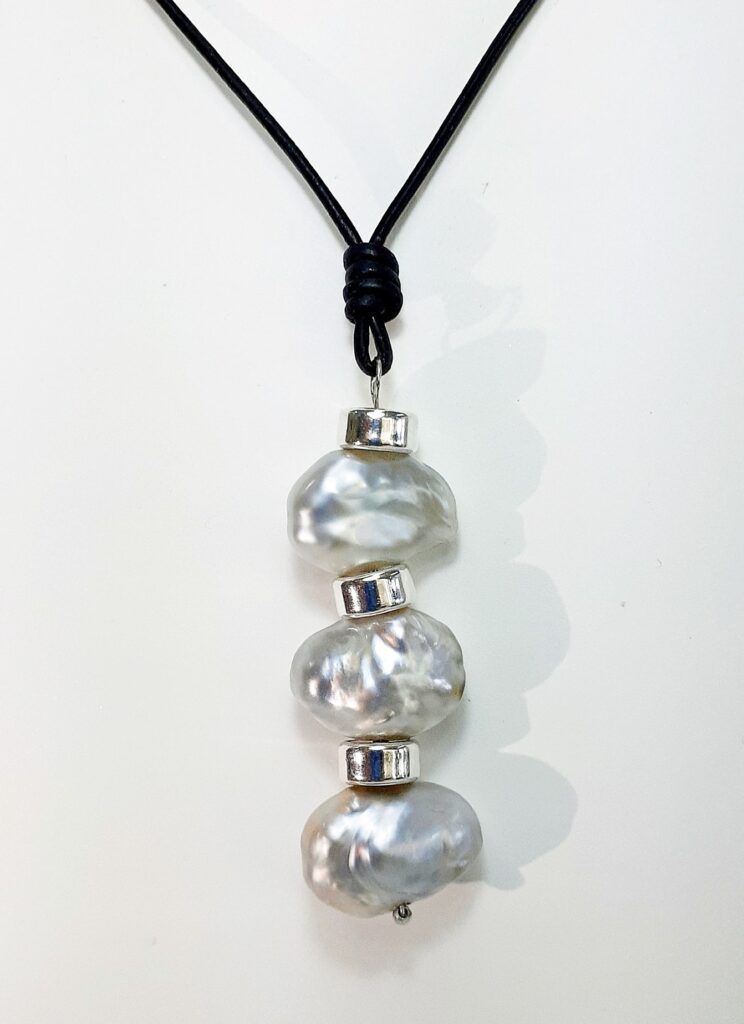The Tahitian cultured pearl
“All the colors of black”
DID YOU SAY BLACK?
You may have noticed: Tahitian black pearls are not… black! Well, not really, or very rarely. They can even be brightly colored: gray, silver, green, blue, yellow, eggplant, gold, pink… The Tahitian cultured pearl can afford anything: it is the only natural pearl in the world to have this sumptuous dark nacre adorned with iridescent pigments, gifts from its mother oyster, the Pinctada Margaritifera, the privileged host of the Polynesian lagoons.
UNIQUE AND RARE
The Tahitian cultured pearl is born from a “nucleus” and a graft introduced into a Pinctada Margaritifera by the pearl grower, a bit of a surgeon, a bit of a magician. Nature, time and… luck do the rest. Because only 30% of the grafted oysters produce pearls. And among them, only a few are perfectly round, uniformly colored and of remarkable size. Yes, a Tahitian pearl is always unique and rare. And so often beautiful.
AUTHENTICALLY YOURS
An authentic Tahitian black pearl is cultivated in the lagoon of an island or atoll of French Polynesia, most often in the Gambier or Tuamotu archipelago.
At the time of your purchase, COCOBLANC gives you a certificate of origin and authenticity. It guarantees the natural and Polynesian origin of your pearl according to the official classification criteria. >
SHAPE
A Tahitian pearl can be :
Round: a near perfect sphere (less than 2% variation in diameter). Obviously the rarest and most sought after shape.
Semi round: almost round (between 2% and 5% variation in diameter). Being almost perfect is also very good.
Button: a sphere just a little flattened, with at least one axis of symmetry.
Semi-baroque: drop-shaped, pear-shaped or oval. Not round at all, but with at least one axis of revolution. A little originality does not hurt.
Circled or ringed: the pearl is equipped with rings or grooves perpendicular to a rotation axis on more than 1/3 of its surface. For non-conformists.
Baroque: totally irregular, without any axis of symmetry, in short it looks like nothing (else). But it can have a crazy charm!
SIZE
Tahitian pearls have a size (diameter or width, depending on the shape) that most often varies between 8 and 12 mm. Exceptional pieces reach 16mm, very rarely more.
CLASSIFICATION
Specific to Tahitian pearls, it can be appreciated with the naked eye according to two criteria: the state of the surface (quantity and distribution of imperfections) and the luster (quality of the reflection of light on the pearl’s surface):
Top gem category: no imperfections and excellent luster. In short, the exception!
A category: no imperfections on at least 90% of the surface. Light and concentrated imperfections on the remaining 10%. Tolerance of one deep imperfection. Very good luster at least.
B category: the surface is free of imperfections on at least 70%. On the remaining 30%, the pearl may have light and concentrated imperfections, with a tolerance of two deep imperfections. Good luster at least.
C category: the surface is free of imperfections on at least 40%. On the remaining 60%, the pearl may have light and concentrated imperfections with a tolerance of 10% of deep imperfections. Minimum of medium luster.
D category: mild imperfections over 60% of the surface, with a tolerance of no more than 20% of deep imperfections and/or white pitting. Low luster at a minimum.
COLOR
This is a secondary criterion, the characterization of which is subjective. Unlike the previous ones, it should not influence the price of the pearl except in the case of very rare and intense uniform colors (white, black, blue, for example). But it is often the color that triggers the heartthrob!
AND THE KESHIS, IN ALL THIS?
A Tahitian keshi (“poppy seed” in Japanese) is a baroque cluster of nacre produced by an oyster that has rejected its nucleus. Long despised as aborted transplants, Tahitian keshis have gradually earned their letters of nobility. They are now adopted by the greatest jewelers for their singular shapes. Small in fame but big in effect, keshis can reach up to 15 mm in diameter and display striking colors.
At COCOBLANC, we particularly like them as bracelets, earrings or pendants.

The Tahitian cultured pearl
OUR OPINION
Each pearl is born from a whim of nature, which is what makes it so beautiful and unique. With the exception of “perfect” pearls, which are very rare, it is therefore normal for a Tahitian pearl to reveal imperfections, more or less visible, more or less acceptable depending on one’s criteria. But let’s face it: there is no such thing as a “bad” Tahitian pearl!
In Polynesia, they say: “It is not you who chooses your pearl, it is the pearl that chooses you”. At COCOBLANC, we agree with this delicious postulate. So, in our boutique, let your heart speak, let yourself be seduced: whatever its shape, size and color, a pearl will be yours. Unique. Eternal.